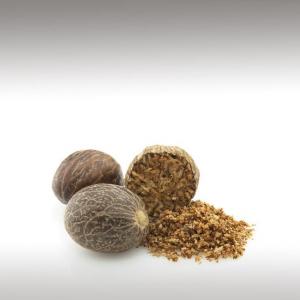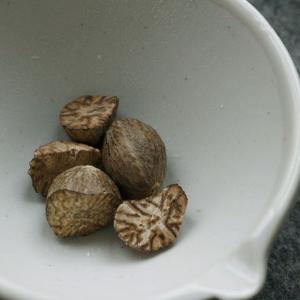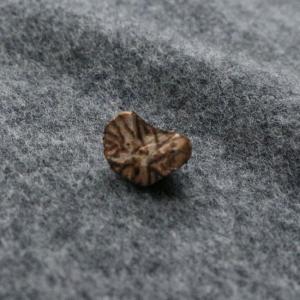
NUTMEG ESSENTIAL OIL (MYRISTICA FRAGRANS) - ESSENTIAL OILS

BASE / GENERAL DATA
Information submited: April 15, 2015 Modified: March 15, 2018 By: OperaDreamhouse
Botanical Name: Myristica fragrans
Common Method of Extraction: Steam distillation
Part Typically Used: Dried seeds
Color: Light yellow
Consistency: Thin
Perfumery Note: Middle
Strength of Initial Aroma: Rich, sweet, woody, sharp, spicy and rather musky in aroma.
Nutmeg is one of the two spices - the other being mace - derived from several species of tree in the genus Myristica. The most important commercial species is Myristica Fragrans, an evergreen tree indigenous to the Banda Islands in the Moluccas (or Spice Islands) of Indonesia. In Indonesia Nutmeg knows in "Pala" name.
When the oil is made from the husks it produces mace. The true Myristica Fragrans essential oil is the oil extracted from the seeds, pure Nutmeg oil.
The common or fragrant Nutmeg, Myristica Fragrans, is native to the Banda Islands in the Moluccas, Indonesia. It is also cultivated on Penang Island in Malaysia, in the Caribbean, especially in Grenada, and in Kerala, a state in southern India.
Nutmeg is the seed of the tree, roughly egg - shaped and about 20 to 30 mm long and 15 to 18 mm wide, and weighing between 5 and 10 g dried, while mace is the dried "lacy" reddish covering or aril of the seed.
The first harvest of Nutmeg trees takes place 7 - 9 years after planting, and the trees reach full production after twenty years. Nutmeg is usually used in powdered form.
Nutmeg was known as a valuable commodity by Muslim sailors from the port of Basra (including the fictional character Sinbad the Sailor in the One Thousand and One Nights). Nutmeg was traded by Arabs during the Middle Ages and sold to the Venetians for high prices, but the traders did not divulge the exact location of their source in the profitable Indian Ocean trade, and no European was able to deduce its location.
The Dutch waged a bloody war, including massacring and enslaving the inhabitants of the islandof Banda, to control nutmeg production in the East Indies in 1621.
The trade in Nutmeg later became dominated by the Dutch in the 17th century. The English and Dutch,through their competing East India and Dutch East India Companies, engaged in prolonged struggles to gain control of Run Island.
As a result of the Dutch interregnum during the Napoleonic Wars, the British took temporary control of the Banda Islands from the Dutch and transplanted Nutmeg trees, complete with soil, to Sri Lanka, Penang, Bencoolen, and Singapore. From these locations they were transplanted to their other colonial holdings elsewhere, notably Zanzibar and Grenada.
The national flag of Grenada, adopted in 1974, shows a stylised split-open Nutmeg fruit. The Dutch retained control of the spice islands until World War II.
Chemical structure:
Myristicin in the essential oil is actually not the agent responsible for the hallucinogenic properties of Nutmeg oil, the chemical known as Elemicin is a non-toxic, relatively safe psychoactive similar to Mescaline.
In low doses, Nutmeg produces no noticeable physiological or neurological response, but in large doses, raw Nutmeg has psychoactive effects. Mace oil has a higher concentration ofmyristicin than normal Nutmeg oil.
Essential oil volatile fraction typically contains 60-80% d-camphene by weight, as well as quantities of d-pinene, limonene, d-borneol, l-terpineol, geraniol, safrole, and myristicin. In its pure form, myristicin is a toxin, and consumption of excessive amounts of Nutmeg can result inmyristicinpoisoning.
Common Method of Extraction: Steam distillation
Part Typically Used: Dried seeds
Color: Light yellow
Consistency: Thin
Perfumery Note: Middle
Strength of Initial Aroma: Rich, sweet, woody, sharp, spicy and rather musky in aroma.
Nutmeg is one of the two spices - the other being mace - derived from several species of tree in the genus Myristica. The most important commercial species is Myristica Fragrans, an evergreen tree indigenous to the Banda Islands in the Moluccas (or Spice Islands) of Indonesia. In Indonesia Nutmeg knows in "Pala" name.
When the oil is made from the husks it produces mace. The true Myristica Fragrans essential oil is the oil extracted from the seeds, pure Nutmeg oil.
The common or fragrant Nutmeg, Myristica Fragrans, is native to the Banda Islands in the Moluccas, Indonesia. It is also cultivated on Penang Island in Malaysia, in the Caribbean, especially in Grenada, and in Kerala, a state in southern India.
Nutmeg is the seed of the tree, roughly egg - shaped and about 20 to 30 mm long and 15 to 18 mm wide, and weighing between 5 and 10 g dried, while mace is the dried "lacy" reddish covering or aril of the seed.
The first harvest of Nutmeg trees takes place 7 - 9 years after planting, and the trees reach full production after twenty years. Nutmeg is usually used in powdered form.
Nutmeg was known as a valuable commodity by Muslim sailors from the port of Basra (including the fictional character Sinbad the Sailor in the One Thousand and One Nights). Nutmeg was traded by Arabs during the Middle Ages and sold to the Venetians for high prices, but the traders did not divulge the exact location of their source in the profitable Indian Ocean trade, and no European was able to deduce its location.
The Dutch waged a bloody war, including massacring and enslaving the inhabitants of the islandof Banda, to control nutmeg production in the East Indies in 1621.
The trade in Nutmeg later became dominated by the Dutch in the 17th century. The English and Dutch,through their competing East India and Dutch East India Companies, engaged in prolonged struggles to gain control of Run Island.
As a result of the Dutch interregnum during the Napoleonic Wars, the British took temporary control of the Banda Islands from the Dutch and transplanted Nutmeg trees, complete with soil, to Sri Lanka, Penang, Bencoolen, and Singapore. From these locations they were transplanted to their other colonial holdings elsewhere, notably Zanzibar and Grenada.
The national flag of Grenada, adopted in 1974, shows a stylised split-open Nutmeg fruit. The Dutch retained control of the spice islands until World War II.
Chemical structure:
Myristicin in the essential oil is actually not the agent responsible for the hallucinogenic properties of Nutmeg oil, the chemical known as Elemicin is a non-toxic, relatively safe psychoactive similar to Mescaline.
In low doses, Nutmeg produces no noticeable physiological or neurological response, but in large doses, raw Nutmeg has psychoactive effects. Mace oil has a higher concentration ofmyristicin than normal Nutmeg oil.
Essential oil volatile fraction typically contains 60-80% d-camphene by weight, as well as quantities of d-pinene, limonene, d-borneol, l-terpineol, geraniol, safrole, and myristicin. In its pure form, myristicin is a toxin, and consumption of excessive amounts of Nutmeg can result inmyristicinpoisoning.

SPIRITUAL PRACTISES DATA

MEDICINE / HEALTH DATA

BEAUTY / COSMETICS DATA

FOOD / COOKING DATA
COMMENTS
No comments.




